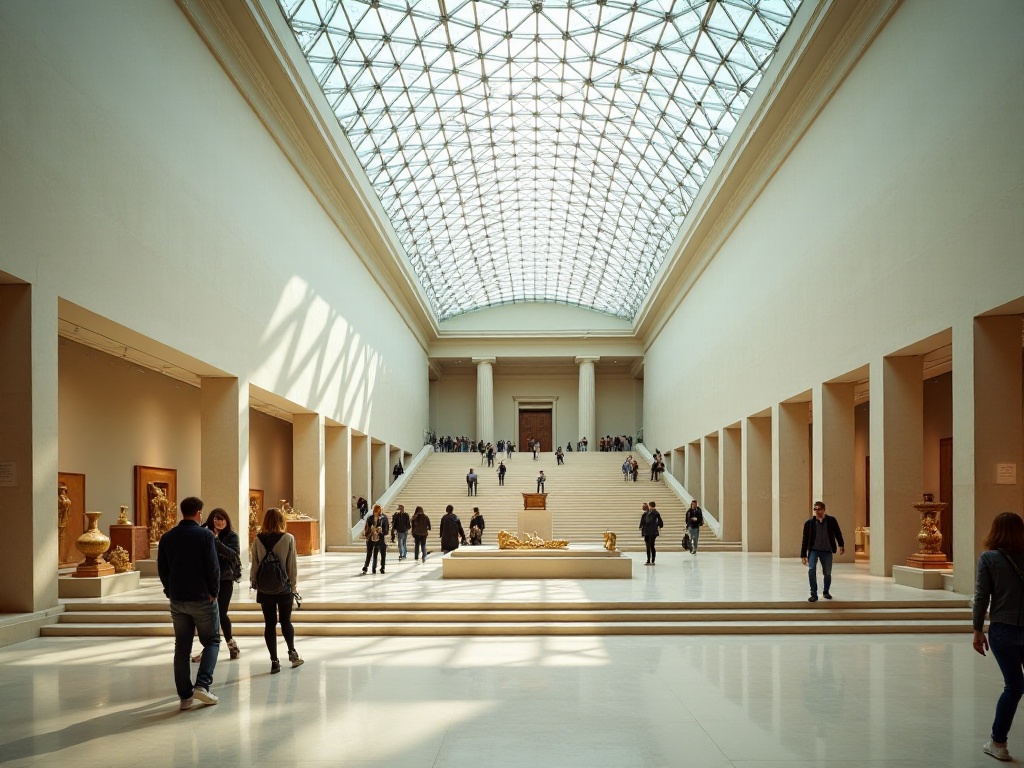Opening Thoughts
As a museum enthusiast who frequently visits museums, I've been to countless institutions. From the Palace Museum and Shanghai Museum in China to the British Museum and the Louvre abroad, I've visited over 50 museums large and small. Every time I visit a new museum, I face the same question: should I hire a tour guide?
To be honest, it's quite a dilemma. Each artifact in a museum has a long history and compelling story behind it, and it feels like a waste to just breeze through. But tour guides can cost hundreds or even thousands - is it really worth the expense? Today I'd like to share my personal experiences and thoughts on this matter.
The Tour Guide Dilemma
I remember hesitating for a long time at the entrance of the British Museum during my first visit. I had just started working then and had saved several months' salary just for the plane ticket to London. Standing at the grand entrance of the British Museum, I looked at the tour guide prices on my phone: at least 100 pounds for half a day, nearly 1000 RMB.
Honestly, that's not a small amount. In London, 100 pounds could get you a night at a nice hotel or a meal at a Michelin-starred restaurant. But then again, I thought, coming all this way only to not understand the exhibits would be such a waste. While I was pondering this, I saw a couple walk in with audio guides from the museum, looking relaxed and at ease. That's when I realized there were many different ways to experience a museum.

Deep Reflection
Whenever I see people taking photos in museums, I wonder: why do we visit museums in the first place? Is it just to check in on social media and show that "I was here"? Or do we genuinely want to understand the stories behind each artifact?
Once at the Louvre, I deliberately spent half an hour observing at the Mona Lisa. Most tourists would quickly take a selfie and leave. The average viewing time was less than 15 seconds. This reminded me of a joke I saw on social media: modern museum visitors are like TikTok users - they stay for three seconds, and if not interested, they swipe away.
But in reality, each artifact is a witness to its era. Take the Rosetta Stone in the British Museum - it's not just a stone, but the key to deciphering ancient Egyptian hieroglyphics. Without professional interpretation, many people might miss these fascinating stories.

Pros and Cons Analysis
Tour guides certainly have many advantages. First, they're professionally trained and thoroughly knowledgeable about the museum's collections. For instance, Teacher Wang, whom I met at the Palace Museum, was not only an expert in Ming and Qing history but also knew many palace anecdotes. He told me that the bronze mirror in Emperor Qianlong's study wasn't for looking at oneself, but for watching for movement behind him to prevent assassinations. These interesting details would be hard to learn just by reading exhibit labels.
Professional guides can also help plan the optimal viewing route. In a place as vast as the British Museum, it's easy to get lost in the maze of galleries without a guide. Guides will help you select the most worthwhile exhibits based on your interests and time constraints. They usually understand the historical context well and can make dry history come alive.
However, there are some downsides to hiring guides. First is the tight scheduling. I remember practically running through the Egyptian Museum with our guide. Seeing thousands of artifacts in two hours left no time to truly appreciate them. Also, guides often stick to fixed scripts, lacking depth and personalized interpretation.
Then there's the cost issue. For major museums like the Louvre, a professional guide might charge around 200 euros for half a day. For families, this can be quite expensive. Some guides also take you to souvenir shops and pressure you to buy things, which can be unpleasant.

Personal Recommendations
After years of experience, I've developed a practical approach to museum visits. For first visits to major museums, I do thorough preparation. First, I study the museum's floor plan to understand the layout of different sections. Then I research online about must-see masterpieces and note their locations.
If budget allows, I recommend using the museum's official audio guide. These usually include detailed explanations of major exhibits at a reasonable price. The British Museum's audio guide, for example, costs just 10 pounds and offers Chinese commentary. Most importantly, you can pace your visit according to your interests, listening as long as you want without worrying about keeping up with a tour guide.
For areas of particular interest, I join the museum's scheduled tours. Many museums offer this service, with staff members leading tours of specific themed exhibits. These tours are usually free, and the staff members are highly knowledgeable. For instance, I joined an Egyptian art tour at the Metropolitan Museum of Art where the staff member not only detailed the mummification process but also answered many technical questions.
If you really want to hire a guide, I suggest choosing one certified by the museum. These guides undergo rigorous training and are guaranteed to be professional. It's best to book online in advance so you can read other visitors' reviews and choose well-rated guides. You can also compare prices and sometimes find group discounts.

Practical Tips
For a good museum experience, relying solely on guides isn't enough - we need to prepare ourselves. First, choose the right time to visit. Weekends and holidays are extremely crowded with long queues at popular exhibits. From my experience, weekday mornings are best. Especially for popular attractions like the British Museum, visiting around 10 AM Tuesday through Thursday means fewer crowds and more time to appreciate the exhibits.
Pre-visit research is also important. Many museums now have websites and apps with detailed exhibit information and virtual galleries. The Palace Museum's digital collection, for example, includes high-resolution images of millions of artifacts with expert commentary. Understanding exhibits beforehand enriches the actual viewing experience.
I always carry a small notebook to record interesting exhibits. Not just names and dates, but also my thoughts and questions. Later, I can research further to deepen my understanding. Sometimes one artifact leads me to discover many related historical stories.
Taking photos is also good practice, not for social media but for learning purposes. Many exhibit labels have lengthy explanations - better to photograph them for later reading than copying them down on the spot. But be mindful of museum photography rules, as some exhibits can't be photographed.

Final Thoughts
Honestly, visiting museums is a very personal experience. Everyone has different interests and naturally different ways of visiting. Some prefer guide explanations, others prefer exploring on their own. But I think the most important thing is maintaining a thirst for knowledge and respect for culture.
There are now over 55,000 museums worldwide, and this number keeps growing. Each museum is like a three-dimensional history book recording human civilization's development. The Parthenon sculptures at the British Museum show us ancient Greek art at its peak; the bronze vessels at the Palace Museum demonstrate ancient Chinese metallurgy; the Vatican Museum's frescoes witness Renaissance artistic achievements.
Once at the Louvre, I met an elderly gentleman who said he visits weekly, spending an entire day in just one gallery each time. He said, "Museums are like time machines - each visit brings new surprises." That really struck me.
So rather than worrying about whether to hire a guide, think about what kind of experience you want. If time allows, explore at your own pace; if time is limited, a guide could be a good choice. The important thing is making the visit an enjoyable learning journey, not just a checklist item.
Do you prefer exploring on your own or listening to guide explanations? Everyone has their own museum stories - feel free to share your experiences in the comments. Your experience might help others who are uncertain.


